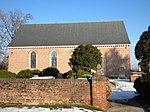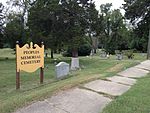Petersburg National Battlefield
American Civil War museums in VirginiaAmerican Civil War on the National Register of Historic PlacesBattlefields of the Eastern Theater of the American Civil WarConflict sites on the National Register of Historic Places in VirginiaHopewell, Virginia ... and 9 more
Museums in Dinwiddie County, VirginiaMuseums in Petersburg, VirginiaNational Battlefields and Military Parks of the United StatesNational Register of Historic Places in Dinwiddie County, VirginiaParks in Dinwiddie County, VirginiaParks in Prince George County, VirginiaPetersburg, VirginiaProtected areas established in 1926Protected areas of Virginia

Petersburg National Battlefield is a National Park Service unit preserving sites related to the American Civil War Siege of Petersburg (1864–65). The battlefield is near the city of Petersburg, Virginia, and includes outlying components in Hopewell, Prince George County, and Dinwiddie County. Over 140,000 people visit the park annually.
Excerpt from the Wikipedia article Petersburg National Battlefield (License: CC BY-SA 3.0, Authors, Images).Petersburg National Battlefield
Hickory Hill Road, Petersburg
Geographical coordinates (GPS) Address Nearby Places Show on map
Geographical coordinates (GPS)
| Latitude | Longitude |
|---|---|
| N 37.219444444444 ° | E -77.361388888889 ° |
Address
Hickory Hill Road 1517
23803 Petersburg
Virginia, United States
Open on Google Maps










